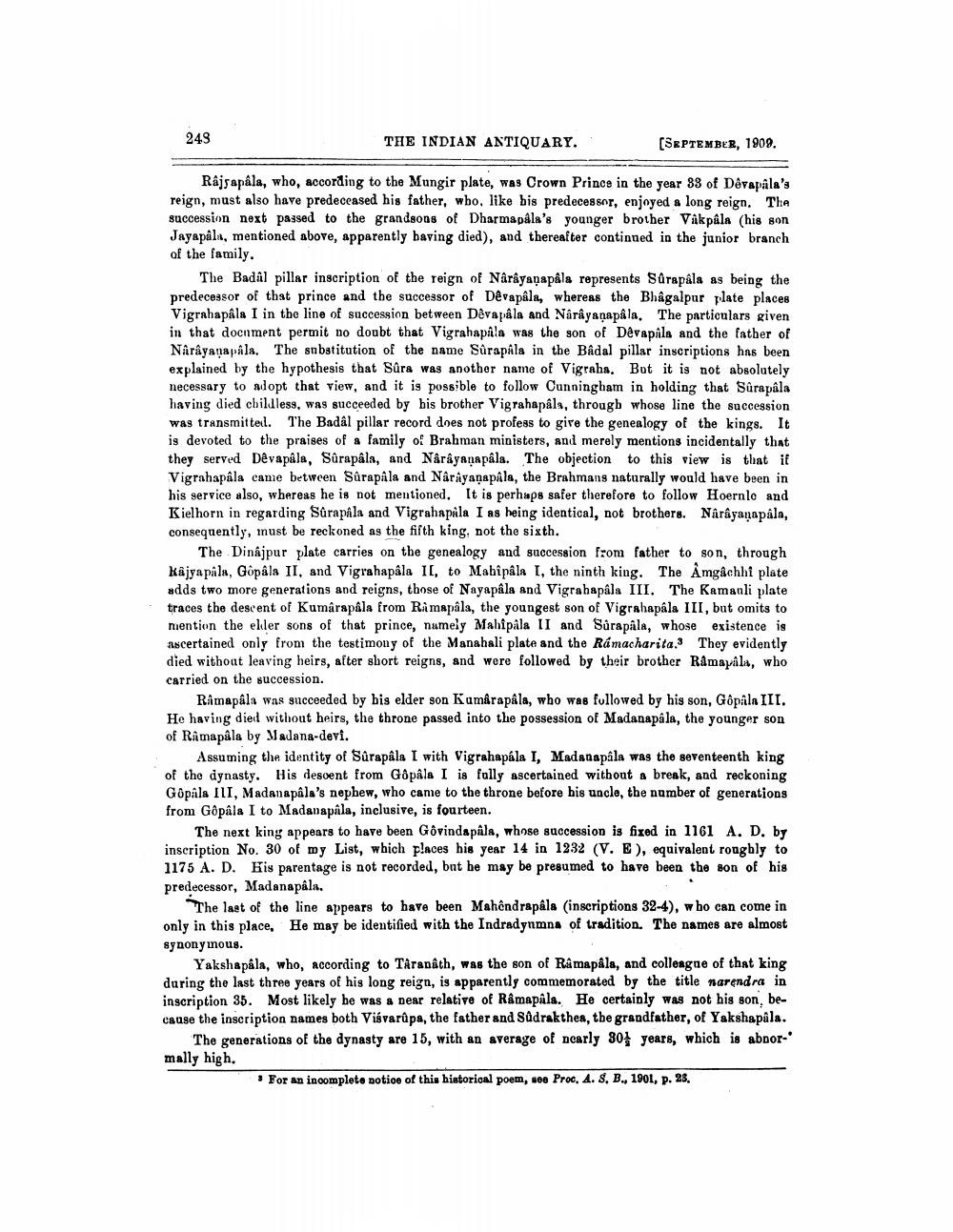________________
243
THE INDIAN ANTIQUARY.
SEPTEMBER, 1909.
Rajsapala, who, according to the Mungir plate, was Crown Prince in the year 88 of Devapala's reign, must also have predeceased his father, who, like his predecessor, enjoyed a long reign. The succession next passed to the grandsons of Dharmapala's younger brother Vakpala (his son Jayapala, mentioned above, apparently baving died), and thereafter continued in the junior branch of the family.
The Badal pillar inscription of the reign of Narayanapåla represents Surapala as being the predecessor of that prince and the successor of Devapala, whereas the Bhagalpur plate places Vigrahapala I in the line of succession between Dêvapala and Narayanapala. The particulars given in that document permit no doubt that Vigrahapala was the son of Devapala and the father of Narayanapala. The snbstitution of the name Sûrapala in the Badal pillar inscriptions has been explained by the hypothesis that Súra was another name of Vigraha. But it is not absolutely necessary to adopt that view, and it is possible to follow Cunningham in holding that Sürapala having died childless, was succeeded by bis brother Vigrahapala, through whose line the succession was transmitteil. The Badâl pillar record does not profess to give the genealogy of the kings. It is devoted to the praises of a family of Brahman ministers, and merely mentions incidentally that they served Dêvapala, Sûrapâla, and Narayanapâla. The objection to this view is that it Vigrahapala came between Sûrapala and Narayanapala, the Brahmans naturally would have been in his service also, whereas he is not mentioned. It is perhaps safer therefore to follow Hoernlo and Kielhorn in regarding Sůrapála and Vigrahapala I as heing identical, not brothers. Narayanapala, consequently, must be reckoned as the fifth king, not the sixth.
The Dinajpur plate carries on the genealogy and succession from father to son, through kâjyapala, Gopala II, and Vigrahapala II, to Mahîpâla I, the ninth king. The Åmgâchhi plate adds two more generations and reigns, those of Nayapala and Vigrahapala III. The Kamanli plate traces the descent of Kumarapala from Ramapala, the youngest son of Vigrahapala III, but omits to mention the elder sons of that prince, namely Mahipala II and Sůrapala, whose existence is ascertained only from the testimony of the Manahali plate and the Ramacharita. They evidently died without leaving heirs, after short reigns, and were followed by their brother Ramapala, who carried on the succession.
Ramapala was succeeded by bis elder son Kamarapala, who was followed by his son, Gopaln III. He having died without heirs, the throne passed into the possession of Madanapala, the younger son of Ramapala by Madana-devi.
Assuming the identity of Sûrapala I with Vigrahapala I, Madanapala was the seventeenth king of the dynasty. His descent from Gôpâla I is fully ascertained without a break, and reckoning Gopala III, Madanapala's nephew, who came to the throne before his uncle, the number of generations from Gopala I to Madanapala, inclusive, is fourteen.
The next king appears to have been Govindapala, whose succession is fixed in 1161 A. D. by inscription No. 30 of my List, which places his year 14 in 1232 (V. E), equivalent roughly to 1175 A. D. His parentage is not recorded, but he may be presumed to have been the son of his predecessor, Madanapala.
The last of the line appears to have been Mahendrapala (inscriptions 32-4), who can come in only in this place. He may be identified with the Indradyumna of tradition. The names are almost synonymous.
Yakshapala, who, according to Taranath, was the son of Ramapala, and colleague of that king during the last three years of his long reign, is apparently commemorated by the title narendra in inscription 35. Most likely be was a Dear relative of Râmapala. He certainly was not his son because the inscription names both Visvarûpa, the father and Sudrakthen, the grandfather, of Yakshapala.
The generations of the dynasty are 15, with an average of nearly 80years, which is abdormally high.
For an incomplete notice of this historical poem, see Proc. 4. S. B., 1901, p. 23.




